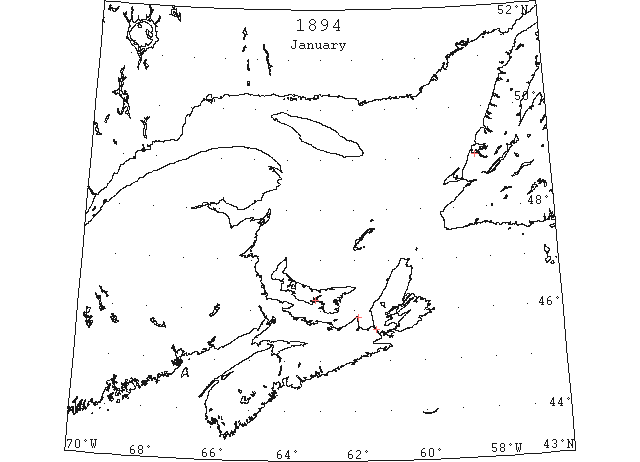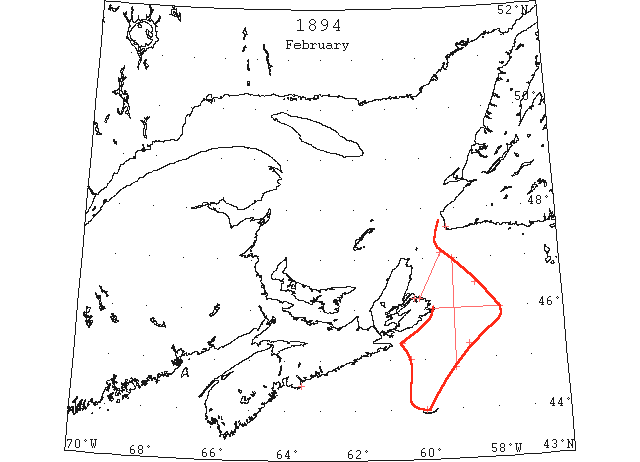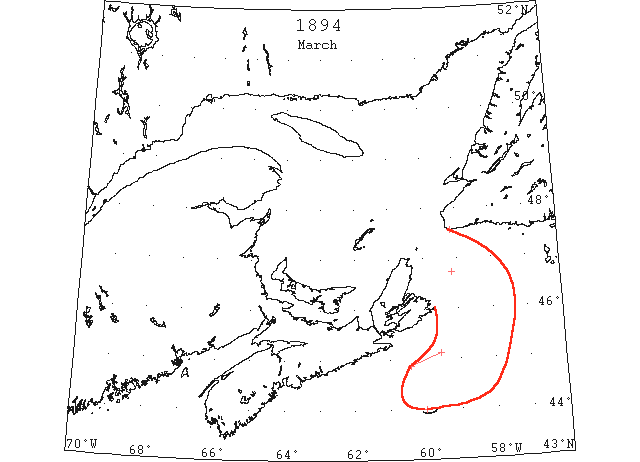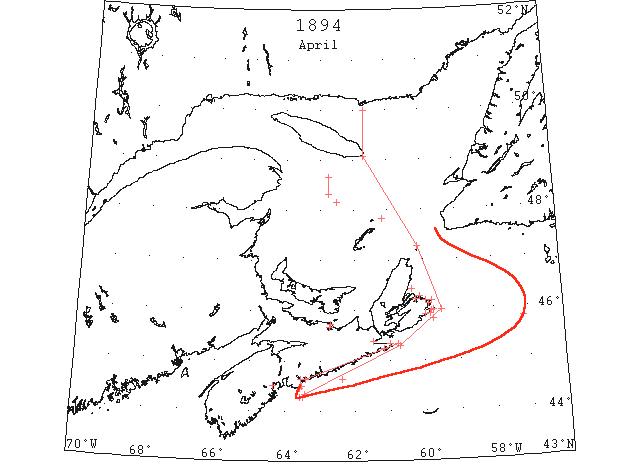
Jan 2 January 2nd sailings: after 2nd – all notices of other ports, not P.E.I. so P.E.I. now closed (Pat 5 Jan 1894 p3#3)
Jan 12 North Sydney, CB, the steamer “Mulgrave” had her rudder disabled by ice in the Strait of Canso. (HH 15/01/1894 p3#3)
Jan 17 North Sydney, the steamer “St. Pierre,” having on board tow schooner crews and a number of passengers arrived at this afternoon from her Newfoundland trip. At Harbor Britain, on the 14th, the “St. Pierre” towed the Newfoundland steamer “Grand Lake” off the shore. Capt. Diggins, of the American schooner “Sarah B. Putnam,” is among the passengers, his vessel having got frozen in the Bay of Islands since the first of the year. The “Putnam” left Beverly, Mass., last July on a fishing and trading voyage. She fished during the autumn on the Labrador and the Strait of Belle Isle, and her trip being unsuccessful she proceeded to Bay of Islands for a cargo of herring, where she got caught in the ice. Captain Diggins let the mate, Alex McDonald, to look after the vessel during the winter months. The schooner “Regina,” of Halifax, is reported clear of the harbor ice at Bay of Islands but jammed in by the drift ice. (HH 18/01/1894 p1 last top)
Jan 18 Georgetown, the steamer “Stanley” left Georgetown, PEI, for Pictou on Friday morning last with mails and passengers. She was out through all the great storm, but comparatively comfortable, as she got into a heavy body of ice near Cape George, where most of the passengers landed. She returned to Georgetown at 6 this evening all right with the mails still on board having failed to reach Pictou. Weather permitting she will leave Georgetown for Pictou to-morrow morning. (HH 19/01/1894 p1 last, bottom)

Feb Issue MWR: Field ice in large quantities was noted near Cape Breton Is. on the 4th and 13th
Feb North Atlantic pilot chart for February show some ice E of Canso in line for Cape Race (dated Feb 4) and some ice midway across the Strait from St. Pierre to Sydney (undated). (PCNAO March 1894)
Feb 2 Schooner “Lothair” – ice extending 80m E of Scatari. (DN)
Feb 3 The steamer “St. Pierre,” arrived yesterday from the south coast of Newfoundland. Left St. Pierre the 1st February and called at all intermediate ports to Channel. Left Channel, February 3rd, and after steamed about 30 miles encountered strips of ice which got heavier as ship proceeded. Altogether ran through about sixty miles of ice. (HH 07/02/1894 p6 #3)
Feb 6 Vast fields of heavy artic ice are reported well up to Sable Island. On the 8th the steamship entered an ice field in 45N 60°25W. Captain Campbell says the ice was at one time piled high as his upper decks cake upon cake. (HH 12/02/1894 p6#3)
Feb 15 The “Barclona”, coming to Halifax from St. John’s bitter cold weather and field ice were encountered. This morning, off Chebucto Head, a big seal was observed on a cake of ice. The size of the animal was generally remarked. Schooner “Caboodle,” from Fortune Bay, arrived Tuesday so badly weighed with ice that very little more would have foundered her. Sunday she came out of Louisburg and was blown to sea. South-east of Scaterie the schooner sailed through sixty miles of drift ice. It was not heavy. (HH 15/02/1894 p3 #2)
Feb 19 North Sydney: Navigation closed. (LL)
Feb 21 The steamer “St. Pierre”, arrived from the south coast of Newfoundland. Left Placentia on Thursday, 15th, but were unable to get through the ice, which had a thickness of seven or eight feet and were compelled to return to Placentia. Left Placentia again on Friday, 10th [sic. Left Channel on Wednesday, 21st, when about 30 miles to the southward of Channel encountered drift ice which got heavier as ship proceeded. The ship was then hauled to the southward and eastward to run clear of the ice. After steaming about 130 in that direction was again hauled on her course for Halifax. (HH 24/02/1894 p1 #4)

Mar Issue MWR: Field ice was noted near Cape Breton Is. and eastern Nova Scotia on the 19th and 24th
Mar North Atlantic pilot chart for March show line of field ice ~40 miles long in ENE direction, midway point about 60 miles N of Sable Island, dated 19 March. (PCNAO April 1894)
Mar The Newfoundland winter mail steamer “Grand Lake” arrived last evening from St. John’s Nfld. She encountered thick fog and heavy gulf ice nearly all the way, and lighter ice on the Nova Scotia coast. The steamer will sail on Tuesday on her return. (HH 03/03/1894 p8 #1)
Mar 1 Off Channel, coast blocked with ice. Brqt. “Minnie” struck ice 70m S of C. Pine. Very large berg off Renews. (DN)
Mar 1 The “Blanche” sought shelter in Port au Basque, Newfoundland, on March 1, when a sudden change of wind filled the harbor with bergs and field ice. The schooner was driven upon the rocks, but was later swept to sea with the ice, which rose high above her masts and swirled about her, grinding, tossing and finally sweeping her under fifty miles from land. The crew of sixteen hurriedly saved themselves by jumping upon a floe in the middle of the night, and upon this they drifted for twenty hours. Fortunately they had been able to toss out a little food and their mattresses, and by making bonfires of the latter they saved themselves from freezing, but they were nearly dead from the exposure when another change in wind drifted to the shore. (HH 21/03/1894 p3#4)
Mar 2 Thick ice off Placentia. Encountered ice 30m S of Channel and hauled 130m SE to clear. (DN).
Mar 21 two schooners arrived at Rimuski, Quebec, March 19 from Bersimis. Navigation in the lower part of the St. Lawrence is now open. (NYMR, p. 10, col. 1)
Mar 28 Schr “Nannie C Bohlin”at Glouster March 22, reports sighting great ice fields near Sable Island. This is unusually early for ice to be sighted in this latitude and indicates an early movement of the ice floes from the Arctic southward. (NYMR, p. 10, col. 3)

Apr Issue MWR: Reports state that easterly gales have packed heavy ice on the shore and in the harbours of Cape Breton Is., blocking navigation even on the southern coast. It is reported that ice was very heavy in the Gulf of St. Lawrence on the 18th. British SS “Newfoundland” which for several days had been jammed in the ice off Cow Bay, CBI, got clear Apr. 19th and proceeded to Halifax. British SS “Premier” was unable to reach her destined port, Montreal, on account of ice, and returned to Halifax. On the 22nd reports state that Halifax harbour was completely blocked by heavy Gulf ice. 6 steamers and 50 sail vessels were detained in port on account of ice. No such blockade has occurred in the past 42 years.
Apr During the latter part of the month [April] an unusually large amount of field ice was packed against the eastern coasts of Nova Scotia and Cape Breton Island by the long prevailing easterly winds, as shown by the following reports. [see below] (PCNAO May 1894)
Apr 5 The “Newfoundland” is in ice off Scatarie with the blades of her propeller gone. A man named Joseph Huelin, a sealer from the SS “Newfoundland,” reached Cow Bay to-day, having travelled four miles over heavy drift ice in order to reach the shore. He succeeded by jumping and crawling on his hands and knees. He reports the ship off Scatarie since Thursday last with only blade of the propeller and trying to work her way through the ice to Cow Bay or North Sydney, to land crew. (HH 12/04/1894 p8 #1)
Apr 6 Steamer “R F Matthews,” Italian ports bound to New York. On the 6th, 45°48’N 57°09’W ran into field ice, and was it seven hours damaging bow plates. The ship made some water, but it is kept clear with her pumps. (HH 09/04/1894 p7 #1)
Apr 8 The steamer “St. Pierre,” arrived yesterday from the south coast of Newfoundland. The “St. Pierre” left Channel, April 8th, enroute for Halifax, and got jammed in the gulf ice about 2 p.m. the same afternoon, in company with four sealing schooners – the “G G”, the “Maud Gilliam” and two others. The “St. Pierre” got clear of the ice at 7 a.m. Tuesday and after steaming about sixty miles on a southerly course, hauled up to the southeast, which course they steered until 5 p.m., when the ship was put on a southeasterly course and steered in that direction until 11 a.m, Wednesday, when they bore up for Halifax. (HH 13/04/1894 p2 #3)
Apr 10 One of the victims of the ice blockade got in here Saturday. It was the little French barquentine “Alfred.” It is twenty –two days since she left St. Pierre, Miq., for Cow Bay. Since then the “Alfred” was eight days in the ice and afterward blown away down to Cape Sable. She go into the ice on the 10th and was held fast until the 18th, drifting to the south and straining all the time. Then a gale blew her a hundred miles to the east. The sails were split and torn and a man named Mace, a seaman, was knocked overboard and drowned. The “Alfred” will repair here before proceeding. (HH 30/04/1894 p2 #3)
Apr 17 SS “Earncliffe” arrived at Halifax so much damaged by ice met outside of Halifax harbour that she will have to go into dry dock. Extensive reefs of heavy ice were reported on the eastern coast of Newfoundland. (MWR)
Apr 17 The steamer “Lake Winnipeg” arrived yesterday at 2 o’clock from Liverpool. The captain reports having passed considerable field ice, including a lot off Chebucto Head. (HH 18/04/1894 p6 #3)
Apr 17 The steamer “Earncliffe of Liverpool arrived yesterday afternoon. She encountered heavy nor east gales for the past six days and at eight yesterday morning, when off Sambro, field ice was observed. The steamer went along the leeward edge of the ice for 17 or 18 miles, and was obliged to go through two miles and one half of it to get into Halifax harbor. It was broken heavy field ice, and some of the pieces were seven to 10 feet thick. The ice could be seen to wind ward as far as the eye could reach. The steamer’s bow was broken in; and the forward or collision bulkhead was filled with water, which put the ship down a great deal by the head. (HH 18/04/1894 p8 #1)
Apr 18 British steamship “Valetta” bound for St. John, NB, foundered in the ice 50 miles east of Halifax. Her crew were saved by the bark “Liberté” (MWR Apr.155.2)
Apr 18 The easterly gales have packed heavy ice on the shore and harbors of Cape Breton Island, blocking navigation even on the southern coast. Westerly winds will open the ports, especially to vessels from the W, which can then pass inside the ice fields. The ice in the Gulf of St. Lawrence is still heavy. (PCNAO May 1894)
Apr 18 The prevailing wind for the last week or ten days has been easterly, and as a result the Gulf and harbors are completely blocked with ice. The “Stanley” which left PEI early last week, has been outside the harbor since Wednesday with the mails and about 35 passengers. On Friday, the mails and some ten passengers landed at Carriboo and came up to town. (HH 18/04/1894 p8 #2)
Apr 19 A Cow Bay, CB, dispatch says: The “Newfoundland” made considerable progress through the ice yesterday off Cow Bay, and is now reported within one mile of the breakwater. Chief Officer Scott, of the sealing steamer “Newfoundland,” arrived in Halifax yesterday. He walked ashore at Cow Bay on Tuesday, with sixty seven of the men. The “Newfoundland” was seven miles off Cow Bay, between Scatterie and Flint Island when Mr. Scott left. She had been hard and fast there for thirteen days. The only accident that happened the “Newfoundland” was the loss of three blades of the propeller. The other one blade turns out six and one half knots. (HH 20/04/1894 p3 #4)
Apr 19 The steamer “Newfoundland” that has been jammed in the ice off Cow Bay for several days, got clear Thursday evening and passed through the Tickle between Scatarie Island and the mainland, proceeding direct to Halifax. ([HH?] 21/04/1894 p2 #2)
Apr 20 Both the “Halifax” and the “Cacouna” pushed a passage into Halifax yesterday; the former at eight o’clock and the latter very early. The “Halifax” met the ice Sunday. The “Cacouna” was off the harbor since Thursday. She met the ice 21 miles west of Thrum Cap, but did not attempt to pass through it until yesterday. The ice is not heavy. The “Cacouna” reports the ice moving east. On Friday, when Captain Whalen found he could not get through the belt, he turned about, steamed back and rounded the western end. The “Cacouna” came east again for six miles between the ice and the shore, but could not with safety get farther. The steamer turned back again, went around and came up opposite Sambro, outside the ice last night. Some of the blocks that were observed were thirty feet high. The Vipond steamer “Premier,” that left here on Monday, 16th inst, for Montreal put back into this port yesterday having failed on account of ice to get up the St. Lawrence river to her destination. On the first day out from Halifax the “Premier” met ice south-east of Sambro, and for two days skirted a ten mile belt of ice that stretched to Scaterie, to St. Paul’s, to Anticosti island and right across the gulf almost to the Labrador coast. Not a channel up the river presented an opening for the steamer anywhere. It was an unbroken and impassable line of field, pan and block ice. On Thursday, therefore, Captain Crowell began to retrace his steps and got into Musgrave & Co.’s dock again yesterday. West India steamer “Duart Castle,” from Bermuda via St. John, NB, was due here Friday night. She was off the harbor like many others unable to make a port on account of the ice and fog until yesterday. The Dominion steamer “Labrador,” from Liverpool, got in about noon. The ship saw no ice until she got down on the Nova Scotia coast and then she saw what had not happened for nearly a half century before. Friday night the “Labrador” was off the harbor. Blocks of ice twenty-five feet high studded the area of vision. They were ugly looking junks. Not until today did the captain resolve to make the harbor. (HH 24/04/1894 p3 #3)
Apr 22 St. John’s: The whole coast of Nova Scotia from Canso to Halifax is blocked with ice. (LL 2 May)
Apr 22 Halifax harbour is completely blocked by heavy gulf ice. Several steamers are overdue presumably on account of the ice. 6 steamers and 50 sail are detained in port for the same reason. No such blockade has occurred in the past 42 years. (PCNAO May 1894)
Apr 23 Impossible to steam through Gulf ice. (NYMR)
Apr 23 Halifax, arrived, steamer “Premier,” Jamaica ports via Halifax 16, bound to Montreal. Put back on account of ice. Was within 45 miles of Heath Point, Anticosti. (HH 24/04/1894 p7 #1)
Apr 24 SS “Sarmatian” from Liverpool to Montreal, stopped at Halifax, being unable to get up the Gulf of St. Lawrence on account of the ice. Leaving next day she encountered heavy .. of Bird Rocks. She met pack ice 12′ thick, covered with seals. (MWR)
Apr 24 North Sydney, CB, while our weather during the past few days had not been very pleasant, owing to rains and dense fog, it has materially assisted in ridding Sydney harbor of ice, which is melting rapidly and will probably be gone by the latter part of week. The drift ice had left out harbor, but the wind, although favorable, has not been strong enough to drive it far off the coast. Consequently scattered ice is to be seen off Louisburg while the harbor and other outports are clear. (HH 25/04/1894 p1#3)
Apr 25 North Sydney, CB, April 25- The ice is loosening, and in a few days of westerly winds will free the coast of ice and open the gulf. The harbor is clear today from the entrance inward, but not seaward. (NYMR May 1? p. 9, col. 2)
Apr 25 Meat Cove, CB, no ice in sight from here or St. Paul’s Island and none at east end of the Magdalens. Only a strip about a mile wide to be seen from the west end. What ice is in the gulf must be between Magdalen Islands and the New Brunswick shore. No reports from Magdalen Islands sealing schooners. One got in with 30 seals. She lost her load by the ice opening on them. (HH 26/04/1894 p4 #2)
Apr 26 North Sydney, about dusk the steamer “Fremona,” being the first to enter our harbor this season, is cautiously steaming in, surrounded by scattered ice. It is understood the “Fremona” is bound for gulf ports. There has been a strong breeze from the northeast, bringing the ice back to our shores, which is now closing Glace Bay and Cow Bay, at which latter place several vessels arrived to-day. (HH 27/04/1894 p1 #4)
Apr 26 Sydney Light, NS, Steamer “Fremona,” from Gibraltar for Montreal, came in from the north with difficulty to-day, got caught in a belt of ice off here and anchored two miles NNE from the station waiting for the ice to pass. (HH 27/04/1894 p7 #1)
Apr 26 The steamer “Newfield” returned to port yesterday afternoon at 3 o’clock, she recovered the Sisters bell buoy, the outer automatic buoy and Egg Island buoy, which were carried away by the ice. The Sambro automatic buoy has disappeared. It has either been crushed by the ice and sunk, or is still drifting. The ice is still ten miles to the south of Sambro, and extends about four miles. It is all field ice. (HH 27/04/1894 p8 #1)
Apr 27 Cow Bay, CB, dispatch received Monday says: The steamer “Bonavista” arrived here at four o’clock Sunday p.m. Capt. Fraser reports ice about five miles off Bras d’Or. Ten o’clock Friday morning came up with the ice at Whitehead; ran out along it to the northward about twenty miles. Found ice getting heavier; came back in shore, found it setting to southeast, leaving opening along the land. Canso bay full. Worked through a strip three miles wide. Very heavy ice. Clear water up to Ganeien [sic] island again; apparently extending off shore as far as the eye could reach. Found opening a mile and a half or two miles wide down to Louisburg. Ice close packed in on Scatterie and Mainadieu. Got into Louisburg Friday evening at six p.m. Saturday morning south-west wind and thick fog. Harbor packed full of heavy ice. At night wind varied to NNE. Left Louisburg nine o’clock Sunday a.m., blowing hard NNE. Worked through a quantity of loose ice close in shore. Saw large quantities of ice off shore, east and south-east as far away as could be seen. Got through loose ice off Scatterie. Clear way from there to Cow Bay. Saw four or five schooners on Sunday working up shore. Let seven or eight lying in Louisburg for coal ports. (HH 01/05/1894 p6#3)
Apr 28 The steamer “St. Pierre,” arrived yesterday from the south coast of Newfoundland. Did not meet with any ice while on the passage to Burin. Left Channel on Saturday, April 21st with foggy weather and light winds which have continued throughout the trip. Passed through the southern part of an ice field yesterday when to the southward of Scatterie. (HH 27/04/1894 p6 #3)
Apr 28 Sydney Light, NS, no ice in sight. Port Mulgrave, NS, not much ice today. (HH 30/04/1894 p7#1)
Apr 30 SS “Pomeranian” 48°10’N 62°30’W sighted 2 fields of pack ice and a schooner fast in the middle of one of them. (MWR)
Apr 30 North Sydney, The barque “Roaks,” from Norway arrived Sunday, the steamer “Pro Patria”, from St. Pierre; the “St. Pierre,” from Halifax and Cow Bay; the schr. “Rosnor,” Capt. Molton, from Channel Nfld., arrived this morning, all with exception of Capt. Angrove, who says there was a little scattered ice off Cow Bay, report no ice on the Cape Breton coast or in the gulf. Schr. “Ellen F,” from a sealing voyage via Magdalen Islands and Ingonish, reports the coast to the northward all clear. Capt. Angrove says the ice has gone by for the season. The “St. Pierre” sailed for St. Pierre and Nfld points, while the “Pro Patria” sails this evening for Halifax. (HH 01/05/1894 p6 #3)
Apr 30 Sydney Light, NS, no ice in sight; harbor ice broken up. Guysboro, bay has been blocked for nearly three weeks with ice. It is moving out last night and today. (HH 01/05/1894 p7 #1)
Apr 30 SS “Parkmore” for Montreal from 48°40’N to 48°20’N in 62°45’W field ice. (NYMR)

May 1 St. Peters, CB, , “Shand”, Richibucto to Sydney, reports met with no ice from Richibucto to Strait of Canso. (HH 02/05/1894 p7 #1)
May 1 Quebec, Gaspe Bay not yet clear of ice. (HH 02/05/1894 p8#4)
May 1 Hawkesbury, May 1st – navigation has opened. The schooner “Hattie Swan” of Richibucto and “Minnie Brine” of Gaspe arrived here from the north yesterday and report they met no ice to trouble them. (Pat 1 May 1894 p3#3)
May 1 Charlottetown, May 1st – Schooner “Sir John A. McDonald” from West Port and Shediac. (Pat 2 May 1894 p3#1)
May 4 North Atlantic Pilot chart has 2 ice sightings May 4 just S of Anticosti Island. (PCNAO June 1894)